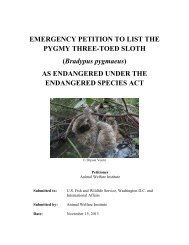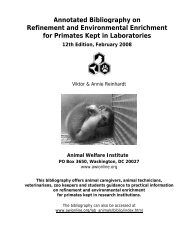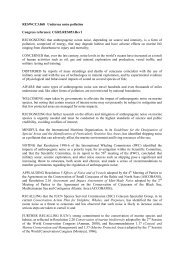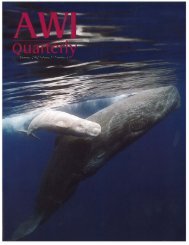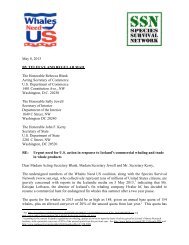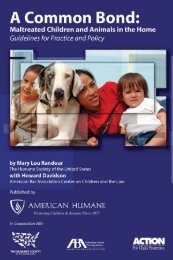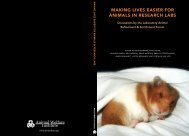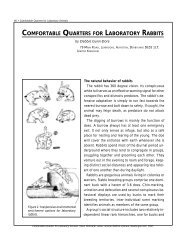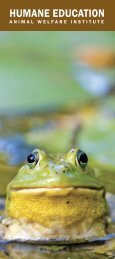AT ION - Animal Welfare Institute
AT ION - Animal Welfare Institute
AT ION - Animal Welfare Institute
You also want an ePaper? Increase the reach of your titles
YUMPU automatically turns print PDFs into web optimized ePapers that Google loves.
The sponsorship of licences should be in the hands<br />
of people more directly in contact with the applicants,<br />
and initially licences should be probationary. The Secretary<br />
of State should be empowered to make regulations<br />
governing the husbandry of laboratory animals. The<br />
career of inspectors should be made more attractive, the<br />
report recommends; recruitment should be restricted to<br />
people with veterinary or medical qualifications, equal<br />
numbers of each. And "The Secretary of State should<br />
be empowered, subject to consultation with the interests<br />
concerned, to prohibit the use in laboratories of animals<br />
not bred for the purpose in registered laboratories or<br />
breeding units outside laboratories."<br />
In addition, and presumably as an interim measure,<br />
the committee suggests that a system of "approved collectors<br />
might be instituted for obtaining animals from<br />
breeders producing animals for purposes other than laboratory<br />
use. Provision for the dissemination of more information<br />
to the public about the nature of animal experimentation<br />
is advocated. This is of fundamental importance<br />
in dispelling any public disquiet, and licensees<br />
would welcome it.<br />
This frank report is exactly what was needed at the<br />
present juncture. Most of those who intend to look at<br />
it will no doubt start with the Summary of Conclusions<br />
and Recommendations, but it is much to be hoped that<br />
they will follow up all the references given there to the<br />
main body of the text and be stimulated into thinking<br />
well beyond that.<br />
Cleveland Amory's <strong>Animal</strong> Kingdom<br />
At World's Fair<br />
A new approach to humane education has been undertaken<br />
by Cleveland Amory. In an exhibit at the Better<br />
Living Center of the World's Fair, a series of glassed-in,<br />
air-conditioned rooms show groups of animals that delight<br />
and fascinate the constant stream of youngsters who<br />
come to look and learn. The old-fashioned farm yard<br />
is the most popular of all, with no battery cages or close<br />
confinement of the so-called "intensive" farm management.<br />
Ducks and geese, rabbits and chickens, a pony, a<br />
calf, a kid and a donkey are on view, probably for the<br />
first time, to many city children. They may, if they come<br />
by at the right time, see a coyote sitting comfortably on<br />
a sofa with a young girl eating a dish of ice-cream —<br />
though, as noted elsewhere in this Information Report,<br />
bounties are still paid that encourage the painful trapping<br />
of these animals in some states.<br />
Altogether, there are eight different rooms, seven containing<br />
animals, one containing an exhibition of animal<br />
protective work done by different, independent humane<br />
organizations throughout the nation. The <strong>Animal</strong> <strong>Welfare</strong><br />
<strong>Institute</strong> has made the illustrated children's leaflets,<br />
"You and Your Dog" and "Kittens and Cats" available<br />
to all the children who attend the exhibition.<br />
Mr. Amory deserves great credit for an original and<br />
positive contribution to the teaching of kindness.<br />
Anti-Cruelty Statutes Upheld<br />
Pigeons have been the target, in the last few years, of<br />
a hate campaign of singular virulence. The cruel poison,<br />
strychnine, has been widely used by officials of government,<br />
and in New York State a bill has been introduced<br />
two years running to exempt pigeons from the provisions<br />
of the anti-cruelty laws which apply to all other animals<br />
except those in scientific institutions being used for experimental<br />
purposes.<br />
It 'is encouraging to report that for the second consecutive<br />
year the bill has failed to pass. Citing the numbers<br />
of letters received in opposition to the bill, the Chairman<br />
of the Senate Committee before whom the bill was<br />
pending, has answered that "after a great deal of study,<br />
we have reached the conclusion that it is not advisable<br />
for the Conservation and Recreation Committee to report<br />
the measure out."<br />
Whenever an attempt is made to weaken the anticruelty<br />
laws, whether by reducing their coverage or depressing<br />
their quality, vigorous citizen protest is in order, and<br />
it can be expected to succeed. Pigeons in New York State<br />
may be captured and painlessly killed, but they continue<br />
to be protected against cruelty by statutory law.<br />
New A.W.I. Manual<br />
by Ernest P. Walker<br />
The manual, "Learning From Our Fellow Mammals," by<br />
Ernest P. Walker is in the final stages of preparation for the<br />
printer. Written for inclusion in the author's three-volume<br />
"Mammals of the World" (Johns Hopkins Press, 1964)<br />
which has already become a classic, it represents the heart<br />
of his thinking on these animals.<br />
The illustrations include many photographs, taken by<br />
the author, of mammals of his own personal acquaintance.<br />
His remarkable work in catching expressions of a wide<br />
variety on the faces of some of those that shared his<br />
apartment carries on ideas about facial expression which<br />
Leonardo da Vinci and, later, Charles Darwin sought to<br />
crystallize.<br />
The manual will be free to teachers and will be available<br />
at cost price (expected to be $1.00) to others. Orders<br />
are being accepted at this time at the office of the<br />
<strong>Institute</strong>.<br />
The Importance of Avoiding Mental<br />
Suffering In Laboratory <strong>Animal</strong>s<br />
The <strong>Animal</strong> <strong>Welfare</strong> <strong>Institute</strong> has long sought to impress<br />
those responsible for the care and management of<br />
laboratory animal colonies with the need to avoid at<br />
least the most obvious causes of mental suffering in animals.<br />
But AWI efforts in this area have met with considerable<br />
resistance. Sentimentality and anthropomorphism<br />
are invoked as explanations for what appears to us to be<br />
the simplest common sense; for example, the observation<br />
that mammals generally suffer from loneliness if<br />
kept in solitary confinement.<br />
For those who insist upon documented physical proof<br />
of distress, the following paper is ieprinted from<br />
SCIENCE, October 25, 1963, Vol. 142, No. 3591,<br />
page 507 with the kind permission of the American Association<br />
for the Advancement of Science, and of the<br />
authors.<br />
LONG-TERM ISOL<strong>AT</strong><strong>ION</strong><br />
STRESS IN R<strong>AT</strong>S<br />
Abstract. Rats isolated for long periods became nervous<br />
and developed caudal dermatitis (scaly tail). After 13<br />
weeks of isolation, rats had heavier adrenals and thyroid<br />
and lighter spleen and thymus compared with rats kept<br />
in community cages. This indicates an endocrinopathy with<br />
hyperfunction of the adrenal cortex.<br />
Toxicity and nutritional studies on rats and mice are<br />
often long term procedures involving the use of animals<br />
confined in individual cages. This arrangement facilitates<br />
clinical observation and allows food consumption data<br />
to be taken on an individual basis. Although this practice<br />
may be desirable and necessary, it is probable that the<br />
data derived from such studies do not reflect the functionings<br />
of a normal animal. In recent years evidence<br />
has accumulated which shows that animals isolated for<br />
long periods of time have altered physiological and behavioral<br />
characteristics. This condition has been referred<br />
to as "isolation stress" by several investigators (1, 2).<br />
In short-term experiments (up to 10 days) isolated<br />
mice or rats have lowered resistance to stress (3), lower<br />
food consumption and weight gain (4) and smaller<br />
adrenals (5) as compared with animals kept in groups<br />
of two or more. Long-term isolation (usually longer than<br />
1 month) may bring about just the opposite effects. The<br />
mouse subjected to long-term isolation has greater food<br />
consumption, and a tendency toward larger adrenals<br />
(2). In addition, lower thyroid, spleen and ovary weights,<br />
increased oxygen consumption, and absolute leukopenia<br />
and eosinopenia have been observed (2). The last mentioned<br />
is suggestive of hyperadrenocorticism. Mice of the<br />
CH strain kept in individual cages were found to have<br />
a higher incidence of convulsive seizures than that found<br />
in paired grouped mice (6). Isolated mice consistently<br />
develop a head twitch similar to that observed in mice<br />
treated with lysergic acid diethylamide (7). The aggressiveness<br />
of the isolated mouse has been used in the testing<br />
of tranquilizers (8). Also, an increase of plasma 17



